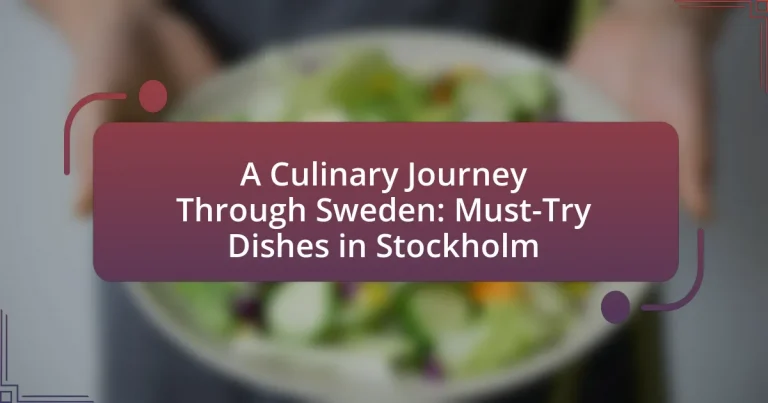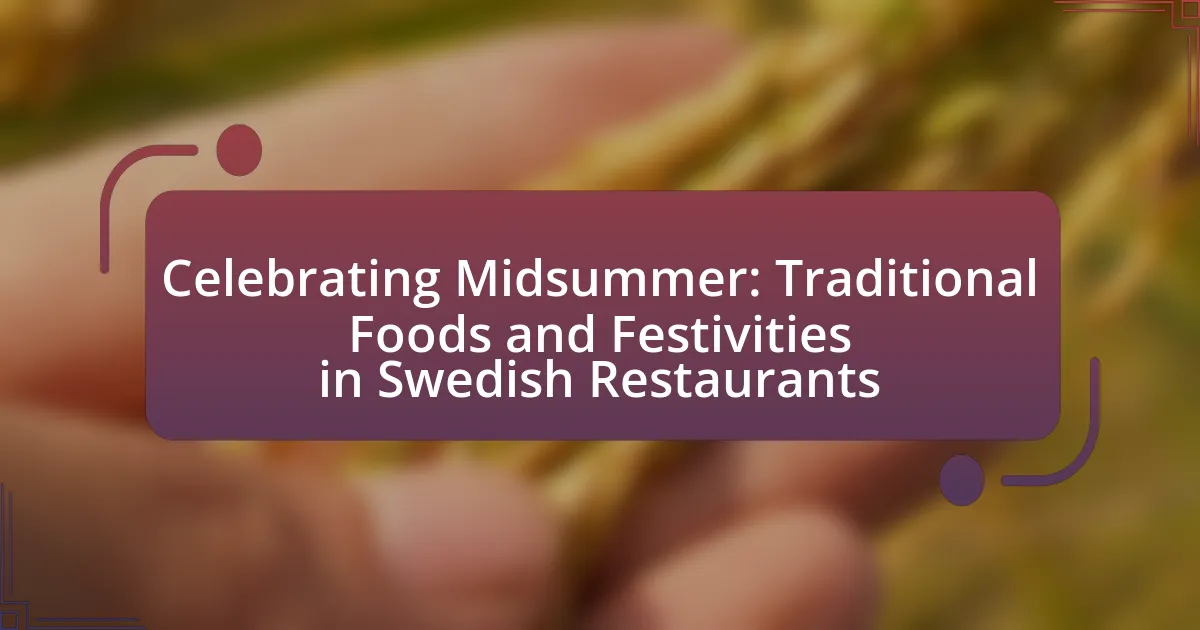A culinary journey through Sweden is characterized by the use of fresh, local ingredients and traditional cooking methods that reflect the nation’s cultural heritage. The article explores iconic Swedish dishes such as meatballs, herring, and gravlax, highlighting their historical significance and the role of seasonal produce. It emphasizes Stockholm as a key destination for experiencing Swedish cuisine, showcasing its diverse food scene, including Michelin-starred restaurants and vibrant markets. Additionally, the article discusses essential dining experiences, popular street food items, and tips for visitors to fully immerse themselves in Stockholm’s culinary offerings.

What defines a culinary journey through Sweden?
A culinary journey through Sweden is defined by its emphasis on fresh, local ingredients and traditional cooking methods that reflect the country’s cultural heritage. This journey includes iconic dishes such as meatballs, herring, and gravlax, which showcase Sweden’s rich agricultural and maritime resources. The use of seasonal produce and foraged ingredients, such as mushrooms and berries, further enhances the authenticity of Swedish cuisine. Additionally, Sweden’s commitment to sustainability and innovation in food preparation, as seen in the rise of New Nordic cuisine, underscores the evolving nature of its culinary landscape.
How does Swedish cuisine reflect the country’s culture and history?
Swedish cuisine reflects the country’s culture and history through its emphasis on local ingredients, traditional preservation methods, and communal dining practices. The use of fish, such as herring and salmon, highlights Sweden’s geographical proximity to the sea and its fishing heritage, while dishes like meatballs and gravlax showcase the influence of agricultural practices and seasonal availability. Historically, the preservation of food through pickling and smoking was essential for survival during long winters, illustrating the resourcefulness of Swedish people. Additionally, the tradition of fika, a coffee break accompanied by pastries, emphasizes the importance of social interaction and community in Swedish culture. These elements collectively demonstrate how Swedish cuisine is deeply intertwined with the nation’s identity and historical context.
What are the key ingredients commonly used in Swedish dishes?
Key ingredients commonly used in Swedish dishes include potatoes, herring, lingonberries, and dill. Potatoes serve as a staple side dish, often prepared in various forms such as boiled or mashed. Herring is a significant component of traditional Swedish cuisine, frequently pickled or served in salads. Lingonberries provide a tart flavor that complements many dishes, particularly meatballs and game. Dill is a prevalent herb used to season fish and sauces, enhancing the overall flavor profile of Swedish meals. These ingredients reflect the country’s culinary traditions and regional availability, contributing to the distinctiveness of Swedish cuisine.
How do traditional cooking methods influence Swedish food?
Traditional cooking methods significantly influence Swedish food by emphasizing preservation techniques such as smoking, pickling, and fermenting. These methods have historical roots in Sweden’s agricultural practices and climate, where long winters necessitated food preservation for sustenance. For example, the traditional method of curing herring through fermentation has been a staple in Swedish cuisine for centuries, allowing for the creation of dishes like sill, which is integral to Swedish smorgasbord. Additionally, the use of wood-fired ovens for baking traditional breads, such as knäckebröd, showcases the importance of these methods in developing distinct flavors and textures that characterize Swedish culinary identity.
Why is Stockholm a significant destination for experiencing Swedish cuisine?
Stockholm is a significant destination for experiencing Swedish cuisine due to its rich culinary heritage and diverse food scene. The city offers traditional dishes such as meatballs, herring, and gravlax, which reflect Sweden’s agricultural and maritime history. Additionally, Stockholm hosts numerous Michelin-starred restaurants and innovative eateries that blend traditional flavors with modern techniques, showcasing the evolution of Swedish cuisine. The city’s vibrant food markets, like Östermalm Market, provide access to local ingredients and artisanal products, further enhancing the culinary experience.
What role does Stockholm play in the evolution of Swedish culinary traditions?
Stockholm serves as a pivotal hub in the evolution of Swedish culinary traditions by blending traditional recipes with modern influences and international flavors. The city’s diverse food scene showcases both classic Swedish dishes, such as meatballs and herring, and innovative culinary practices, reflecting a fusion of local ingredients and global techniques. Notably, Stockholm is home to numerous Michelin-starred restaurants, which elevate Swedish cuisine on the world stage and encourage chefs to experiment with traditional dishes. This dynamic culinary landscape is further supported by events like the Stockholm Food & Wine Festival, which promotes local produce and culinary craftsmanship, thereby reinforcing the city’s role as a leader in the ongoing development of Swedish gastronomy.
How does the city’s food scene compare to other regions in Sweden?
The city’s food scene is more diverse and internationally influenced compared to other regions in Sweden. Stockholm boasts a wide range of culinary offerings, from traditional Swedish dishes to global cuisines, reflecting its status as a cosmopolitan capital. For instance, the city features over 3,000 restaurants, including Michelin-starred establishments, which is significantly higher than many other Swedish cities. This variety allows for a richer dining experience, showcasing both local ingredients and international flavors, making Stockholm a culinary hub in Sweden.

What are the must-try dishes in Stockholm?
The must-try dishes in Stockholm include Swedish meatballs, herring, gravlax, and toast skagen. Swedish meatballs, typically served with lingonberry sauce and creamy gravy, are a staple of Swedish cuisine and reflect the country’s culinary heritage. Herring, often pickled or marinated, is a common feature in traditional Swedish smorgasbord, showcasing the importance of seafood in the region. Gravlax, a cured salmon dish seasoned with dill and sugar, highlights the Nordic approach to preserving fish. Toast skagen, a shrimp salad on toast, combines flavors of seafood and mayonnaise, representing modern Swedish dining. These dishes are integral to experiencing Stockholm’s rich culinary landscape.
What are the iconic dishes that represent Stockholm’s culinary landscape?
The iconic dishes that represent Stockholm’s culinary landscape include Swedish meatballs, herring, and gravlax. Swedish meatballs, known as köttbullar, are traditionally served with lingonberry sauce and creamy gravy, reflecting the country’s comfort food heritage. Herring, often pickled or marinated, is a staple in Swedish cuisine, showcasing the importance of seafood in the region. Gravlax, a cured salmon dish seasoned with dill and sugar, highlights Stockholm’s seafood traditions and is commonly served with mustard sauce. These dishes collectively embody the flavors and culinary practices that define Stockholm’s food culture.
What is the history behind the famous Swedish meatballs?
Swedish meatballs, known as köttbullar, have a rich history that dates back to the 18th century. They were influenced by various culinary traditions, particularly from Italy, as King Charles XII brought back recipes after his exile in the early 1700s. The dish became popular in Sweden due to its versatility and the use of locally available ingredients such as beef, pork, and spices. Traditionally served with lingonberry sauce and creamy gravy, Swedish meatballs have become a staple in Swedish cuisine and are often associated with festive occasions and family gatherings. Their prominence was further solidified by their inclusion in the menu of IKEA, which introduced them to a global audience, making them synonymous with Swedish culinary culture.
How is gravlax prepared and served in Stockholm?
Gravlax is prepared in Stockholm by curing fresh salmon with a mixture of salt, sugar, and dill for several days, allowing the flavors to penetrate the fish. The traditional method involves placing the salmon fillet skin-side down, covering it with the curing mixture, and then weighing it down to ensure even curing. After about 48 hours, the gravlax is ready to be sliced thinly.
In Stockholm, gravlax is typically served with accompaniments such as mustard sauce, fresh bread, and sometimes pickled vegetables, enhancing its flavor profile. This dish is a staple in Swedish cuisine and is often featured in smorgasbord, a traditional buffet-style meal.
What unique flavors can be found in Stockholm’s street food?
Stockholm’s street food features unique flavors such as herring, meatballs, and reindeer. Herring is often pickled and served in various marinades, showcasing Sweden’s coastal heritage. Meatballs, typically made from a blend of beef and pork, are seasoned with spices and served with lingonberry sauce, reflecting traditional Swedish cuisine. Reindeer, often grilled or served in a wrap, offers a distinct taste that highlights the country’s Arctic influences. These flavors collectively represent Stockholm’s rich culinary landscape, blending local ingredients with cultural traditions.
What are the most popular street food items in the city?
The most popular street food items in Stockholm include hot dogs, kebabs, and Swedish meatballs. Hot dogs, often served with a variety of toppings, are a staple at street vendors throughout the city. Kebabs, particularly döner kebabs, are widely enjoyed for their flavorful meat and fresh vegetables. Swedish meatballs, typically served with lingonberry sauce and creamy gravy, have also gained popularity as a quick street food option. These items reflect the local culinary culture and are frequently found at food stalls and markets across Stockholm.
How do local markets contribute to Stockholm’s street food culture?
Local markets significantly enhance Stockholm’s street food culture by providing diverse, fresh ingredients and a platform for local vendors. These markets, such as Östermalm Market Hall and Hötorgshallen, showcase traditional Swedish foods and international cuisines, allowing street food vendors to source high-quality produce and unique flavors. The presence of these markets fosters a vibrant food scene, encouraging culinary innovation and attracting both locals and tourists. For instance, the popularity of food stalls at local markets has led to an increase in food festivals, further integrating street food into the city’s culinary identity.
How can visitors fully experience Stockholm’s culinary offerings?
Visitors can fully experience Stockholm’s culinary offerings by exploring a diverse range of dining options, including traditional Swedish cuisine, modern interpretations, and international flavors. Engaging in food tours, such as those offered by local guides, allows visitors to sample iconic dishes like meatballs, herring, and gravlax while learning about their cultural significance. Additionally, dining at renowned restaurants, such as Oaxen Slip and Smorgastarteriet, provides insight into the farm-to-table movement and the use of local ingredients. The city’s vibrant food markets, like Östermalm Market Hall, further enhance the culinary experience by showcasing artisanal products and local delicacies.
What are the best restaurants to try traditional Swedish dishes in Stockholm?
The best restaurants to try traditional Swedish dishes in Stockholm include Tradition, Pelikan, and Smorgastarteriet. Tradition is renowned for its authentic Swedish meatballs and herring dishes, reflecting classic recipes. Pelikan, located in Sodermalm, offers a historic ambiance and serves traditional fare like gravlax and cured salmon. Smorgastarteriet focuses on modern interpretations of Swedish cuisine, featuring locally sourced ingredients and seasonal dishes. These establishments are well-regarded for their commitment to preserving Swedish culinary heritage, making them top choices for experiencing traditional flavors in Stockholm.
How do these restaurants showcase local ingredients and recipes?
Restaurants in Stockholm showcase local ingredients and recipes by sourcing produce from nearby farms and utilizing traditional cooking methods. For example, many establishments feature dishes made with fresh seafood from the Baltic Sea, such as herring and salmon, highlighting the region’s maritime heritage. Additionally, seasonal vegetables and herbs are often incorporated into menus, reflecting the local agricultural landscape. This commitment to local sourcing not only supports regional farmers but also enhances the authenticity of the culinary experience, allowing diners to taste the unique flavors of Swedish cuisine.
What dining experiences should not be missed in the city?
In Stockholm, dining experiences that should not be missed include enjoying traditional Swedish meatballs at Pelikan, sampling herring at Smorgastarteriet, and indulging in a fika with cinnamon buns at Vete-Katten. Pelikan, established in 1903, is renowned for its authentic Swedish cuisine, while Smorgastarteriet focuses on seasonal ingredients and traditional recipes, showcasing the rich flavors of Swedish herring. Vete-Katten, a historic café, offers a quintessential fika experience, emphasizing the cultural importance of coffee and pastries in Sweden. These establishments reflect the culinary heritage of Stockholm and provide a genuine taste of Swedish culture.
What tips can enhance a culinary journey through Stockholm?
To enhance a culinary journey through Stockholm, prioritize exploring local markets, such as Östermalm Market Hall, which offers a variety of traditional Swedish foods and artisanal products. Engaging with local chefs through cooking classes can provide authentic insights into Swedish cuisine, allowing for hands-on experience with dishes like meatballs and herring. Additionally, dining at restaurants that focus on New Nordic cuisine, such as Oaxen Slip, showcases seasonal ingredients and innovative cooking techniques. Research indicates that experiencing local food culture significantly enriches travel experiences, making these activities essential for a comprehensive culinary exploration in Stockholm.
How can visitors find authentic Swedish food experiences?
Visitors can find authentic Swedish food experiences by exploring local markets, dining at traditional restaurants, and participating in food tours. Local markets, such as Östermalm Market Hall in Stockholm, offer a variety of traditional Swedish foods, including cured herring and meatballs, allowing visitors to taste local flavors. Dining at restaurants that focus on Swedish cuisine, like Pelikan or Tradition, provides an opportunity to enjoy classic dishes prepared with regional ingredients. Additionally, food tours led by knowledgeable guides can offer insights into Swedish culinary traditions and introduce visitors to hidden gems that serve authentic dishes.
What are some common dining etiquette practices in Sweden?
Common dining etiquette practices in Sweden include waiting for everyone to be served before starting to eat, keeping hands on the table but not elbows, and using utensils for most foods. Additionally, it is customary to say “Tack för maten” (Thank you for the food) after a meal to express gratitude. These practices reflect Swedish values of respect and consideration for others during meals.





